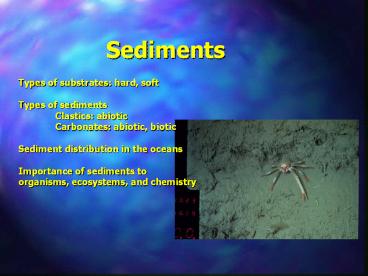Sediments - PowerPoint PPT Presentation
1 / 21
Title:
Sediments
Description:
Sediments Types of substrates: hard, soft Types of sediments Clastics: abiotic Carbonates: abiotic, biotic Sediment distribution in the oceans Importance of sediments to – PowerPoint PPT presentation
Number of Views:337
Avg rating:3.0/5.0
Title: Sediments
1
Sediments
Types of substrates hard, soft Types of
sediments Clastics abiotic Carbonates
abiotic, biotic Sediment distribution in the
oceans Importance of sediments to organisms,
ecosystems, and chemistry
2
Substrate types
Hard bottoms rocks, hardgrounds, other
organisms, and artifical substrates Energy
waves, currents Epibiosis
3
Substrate types
Soft bottoms muds, sands, gravels semi-hard to
soupy Energy determines grain size Infauna and
epifauna Bioturbation Oxygenation and anoxia
4
Sediment properties
Texture size assortment Maturity clay amount,
sorting, roundness
5
Clastic (lithogenous) sediments
The Rock Cycle
Pebbles, sand, silt, clay Abiotic, but can have
biotic help in weathering Weathered rocks
(chemical and physical)
6
Sediment Deposition
Particles into drainage basins then into
oceans Particle size is determined by energy of
transport FW input, storm transport Exception
ice Distance from shore deposition determined by
amount of input, size of particles, energy
7
Carbonate sediments
Calcium carbonate CaCO3 formation and
dissolution
CaCO3 H2O CO2 ? Ca2 2HCO3-
Calcium carbonate water carbon dioxide ?
calcium bicarbonate
8
Carbonate sediments
Abiotic precipitation (rare) Biotic
precipitation shells, etc. Soft substrates,
grain types peloids, pellets Ooid
sands Shell debris Halimeda
9
Carbonate sediments
Weathering algal borings breakage
dissolution Role of CO2 and anthropogenic
effects
10
Carbonate sediments
Cambrian explosion 535 MY
11
Ocean sediment distribution
Tropics Carbonate, clastics on
shelf Polar regions Cold carbonates, ice float
and boulder drops
Depth Energy Proximity to land Chemistry
12
Shallow sediments
Variable sed rates Relict sediments Turbidites Gl
acial deposits Stromatolites Reefs
13
Deep sediments
Low sed rates Abyssal clay Oozes Organic
detritus Dust Phosphate nodules
14
Sediments and Organisms
Benthos versus Nekton, Plankton Soupy to firm
bed different organisms Sessile versus
vagile Epifauna, infauna
15
Sediments and Organisms
Organisms modify environment Bioturbation Reefs
16
Sediments and Organisms
Feeding stragegies filter feeding, deposit
feeding, scavenging, predation
17
Sediments and Organisms
Larvae, adults, and recruitment Many benthic
organisms have planktic larval stage Settlement
and metamorphosis cues
18
Sediments and Ecosystems
Stratified sediments versus bioturbation Grain
size effects Energy effects
19
Sediments and Ecosystems
Microbial loop detrital food chain and nutrient
recycling Important part of ecosystem in shallow
water Benthic singe-celled algae
20
Sediments and Ecosystems
Succession Environmental
perturbation Predictable seasonality (T,
precipitation) Unpredictable large storms,
anthropogenic effects
21
Sediments and Chemistry
Nutrient recycling microbial loop,
algae Nutrient, carbon sink Sediments buffered
from salinity changes Anoxia at depth Toxin
filter Pollution trap































